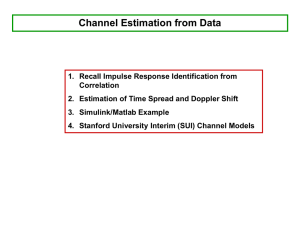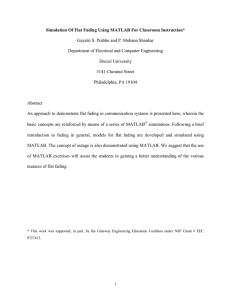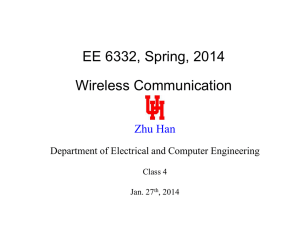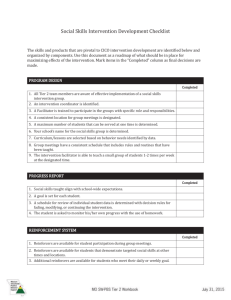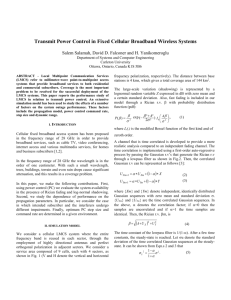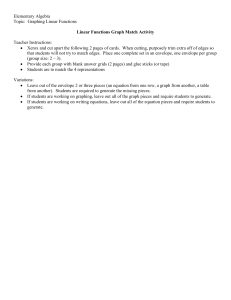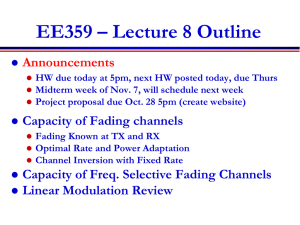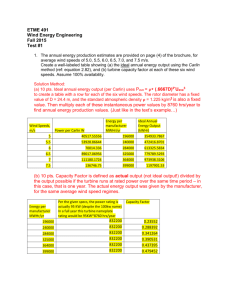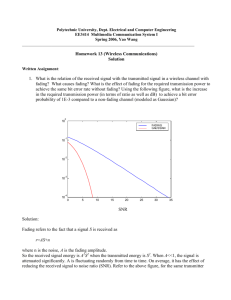manuscript_fading - Electrical and Computer Engineering
advertisement
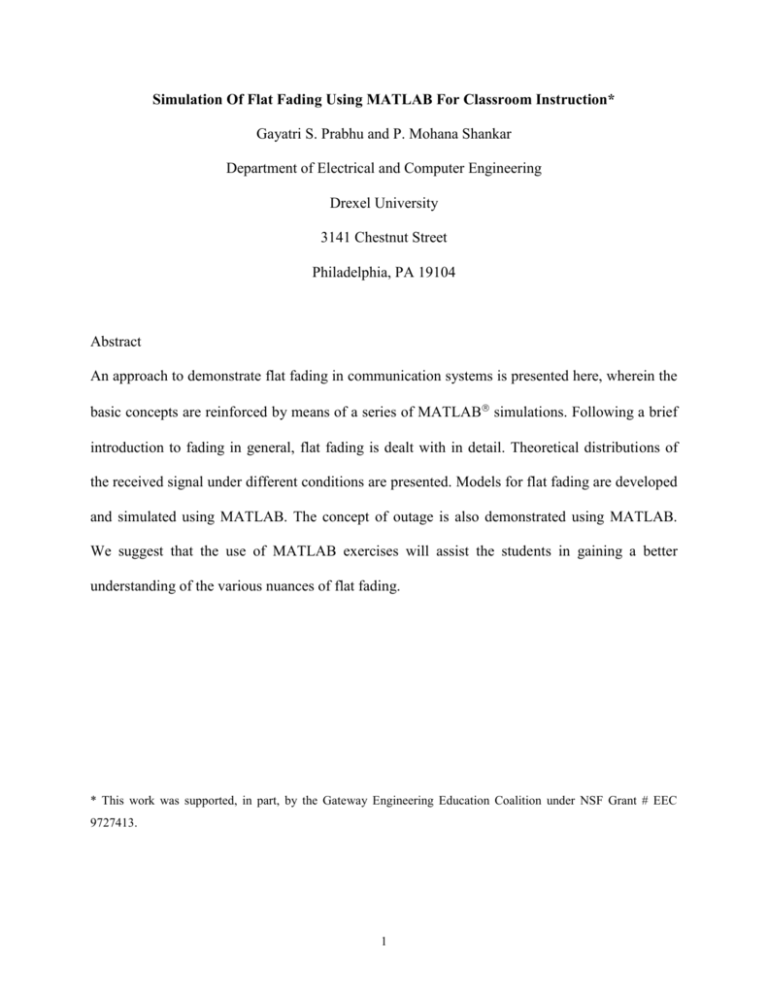
Simulation Of Flat Fading Using MATLAB For Classroom Instruction*
Gayatri S. Prabhu and P. Mohana Shankar
Department of Electrical and Computer Engineering
Drexel University
3141 Chestnut Street
Philadelphia, PA 19104
Abstract
An approach to demonstrate flat fading in communication systems is presented here, wherein the
basic concepts are reinforced by means of a series of MATLAB simulations. Following a brief
introduction to fading in general, flat fading is dealt with in detail. Theoretical distributions of
the received signal under different conditions are presented. Models for flat fading are developed
and simulated using MATLAB. The concept of outage is also demonstrated using MATLAB.
We suggest that the use of MATLAB exercises will assist the students in gaining a better
understanding of the various nuances of flat fading.
* This work was supported, in part, by the Gateway Engineering Education Coalition under NSF Grant # EEC
9727413.
1
I. INTRODUCTION
Wireless communications is one of the fastest growing areas in Electrical Engineering.
Because of this, courses in wireless communications are being offered as a part of the electrical
engineering curriculum at the undergraduate and graduate level. With the incorporation of
computers in the curriculum [1], [2], it has become much easier to bring some of the concepts of
this new and exciting field of wireless communications into the classrooms. MATLAB is
extensively being used in colleges and universities to accomplish this integration of computers
and curriculum. In this paper, a MATLAB based approach is proposed and implemented to
demonstrate the concept of fading, one of the topics in wireless communications.
Before delving into the details of the way in which MATLAB is used as a learning tool, it
is necessary to understand underlying principles of fading in wireless systems. This is done in
Section II. Mathematical models are used in Section III to describe the concept of flat fading.
Section IV shows how MATLAB can be used to reinforce these concepts, and the observations
obtained from the MATLAB simulations are discussed. The use of these results in the
calculation of outage probability is presented in Section V. Finally, the conclusions are presented
in Section VI.
II. FADING IN A WIRELESS ENVIRONMENT
Radio waves propagate from a transmitting antenna, and travel through free space
undergoing reflection, refraction, diffraction, and scattering. They are greatly affected by the
ground terrain, the atmosphere, and the objects in their path, like buildings, bridges, hills, trees,
etc. These multiple physical phenomena are responsible for most of the characteristic features of
the received signal.
2
In most of the mobile or cellular systems, the height of the mobile antenna may be much
lower than the surrounding structures. Thus, the existence of a direct or line-of-sight path
between the transmitter and the receiver is highly unlikely. In such a case, propagation is mainly
due to reflection and scattering from the buildings and by diffraction over and/or around them.
So, in practice, the transmitted signal arrives at the receiver via several paths with different time
delays creating a multipath situation as in Fig.1.
At the receiver, these multipath waves with randomly distributed amplitudes and phases
combine to give a resultant signal that fluctuates in time and space. Therefore, a receiver at one
location may have a signal that is much different from the signal at another location, only a short
distance away, because of the change in the phase relationship between the incoming radio
waves. This causes significant fluctuations in the signal amplitude. This phenomenon of random
fluctuations in the received signal level is termed as fading.
The short-term fluctuation in the signal amplitude caused by the local multipath is called
small-scale fading, and is observed over distances of about half a wavelength. On the other hand,
long-term variation in the mean signal level is called large-scale fading. The latter effect is a
result of movement over distances large enough to cause gross variations in the overall path
between the transmitter and the receiver. Large-scale fading is also known as shadowing,
because these variations in the mean signal level are caused by the mobile unit moving into the
shadow of surrounding objects like buildings and hills. Due to the effect of multipath, a moving
receiver can experience several fades in a very short duration, or in a more serious case, the
vehicle may stop at a location where the signal is in deep fade. In such a situation, maintaining
good communication becomes an issue of great concern, although passing objects often disturb
the field pattern, reducing the risk of the signal remaining in deep fade for a long time.
3
Small-scale fading can be further classified as flat or frequency selective, and slow or fast
[3]. A received signal is said to undergo flat fading, if the mobile radio channel has a constant
gain and a linear phase response over a bandwidth greater than the bandwidth of the transmitted
signal. Under these conditions, the received signal has amplitude fluctuations due to the
variations in the channel gain over time caused by multipath. However, the spectral
characteristics of the transmitted signal remain intact at the receiver. On the other hand, if the
mobile radio channel has a constant gain and linear phase response over a bandwidth smaller
than that of the transmitted signal, the transmitted signal is said to undergo frequency selective
fading. In this case, the received signal is distorted and dispersed, because it consists of multiple
versions of the transmitted signal, attenuated and delayed in time. This leads to time dispersion
of the transmitted symbols within the channel arising from these different time delays resulting
in intersymbol interference (ISI).
When there is relative motion between the transmitter and the receiver, Doppler spread is
introduced in the received signal spectrum, causing frequency dispersion. If the Doppler spread
is significant relative to the bandwidth of the transmitted signal, the received signal is said to
undergo fast fading. This form of fading typically occurs for very low data rates. On the other
hand, if the Doppler spread of the channel is much less than the bandwidth of the baseband
signal, the signal is said to undergo slow fading.
The work reported here will be confined to flat fading. Results on lognormal fading are
also presented because of the existence of some general approaches, which incorporate short
term and long term fading resulting in a single model.
4
III. STATISTICAL MODELING OF FLAT FADING
In a multipath environment, if the difference in the time delay of the number of paths is
less than the reciprocal of the transmission bandwidth, the paths cannot be individually resolved.
These paths also have random phases. They add up at the receiver according to their relative
strengths and phases. The envelope of the received signal is therefore a random variable. This
random nature of the received signal envelope is referred to as fading and may be described by
different statistical models. These models are described below [4]:
(a) Rayleigh Distribution
As discussed earlier, the mobile antenna, instead of receiving the signal over one line-ofsight path, receives a number of reflected and scattered waves, as shown in Fig.1. Because of the
varying path lengths, the phases are random, and consequently, the instantaneous received power
becomes a random variable. In the case of an unmodulated carrier, the transmitted signal at
frequency c reaches the receiver via a number of paths, the ith path having an amplitude ai, and a
phase i. The received signal s(t) can be expressed as
N
ct i
N
s(t) = Re ai e j
ai cos( c t i )
i 1
i 1
…(1)
where N is the number of paths. The phase i depends on the varying path lengths, changing by
2 when the path length changes by a wavelength. Therefore, the phases are uniformly
distributed over [0,2].
5
Effect of motion
Let the ith reflected wave with amplitude ai and phase i arrive at the receiver from an
angle i relative to the direction of motion of the antenna. The Doppler shift of this wave is given
by
d i
cv
c
cos i
…(2)
where v is the velocity of the mobile, c is the speed of light (3x108 m/s), and the i’s are
uniformly distributed over [0,2].
The received signal s(t) can now be written as
N
s(t) =
a
i 1
i
cos( c t d i t i )
…(3)
Expressing the signal in inphase and quadrature form, eqn. (3) can be written as
s(t ) I (t ) cos c t Q(t ) sin c t
…(4)
where the inphase and quadrature components are respectively given as
N
I(t) =
a
i 1
i
cos( d i t i )
N
Q(t) =
a sin(
i 1
i
di
t i )
…(5)
…(6)
Probability density function of the received signal envelope
If N is sufficiently large, by virtue of the central limit theorem, the inphase and quadrature
components I(t) and Q(t) will be independent Gaussian processes which can be completely
characterized by their mean and autocorrelation function [5]. In this case, the means of I(t) and
6
Q(t) are zero. Furthermore, I(t) and Q(t) will have equal variances, 2, given by the mean-square
value or the mean power. The envelope, r(t), of I(t) and Q(t) is obtained by demodulating the
signal s(t) as shown in Fig.2. The received signal envelope is given by
r (t ) I 2 (t ) Q 2 (t )
…(7)
and the phase is given by
Q(t )
I (t )
arctan
…(8)
The probability density function (pdf) of the received signal amplitude (envelope), f(r), can be
shown to be Rayleigh [5] given by
r2
,
f (r ) 2 exp
2
2
r
r0
…(9)
The cumulative distribution function (cdf) for the envelope is given by
r2
F (r ) f (r )dr 1 exp
2
2
0
r
…(10)
The mean and the variance of the Rayleigh distribution are / 2 and (2-/2)2, respectively.
The phase is uniformly distributed over [0,2]. The instantaneous power is thus exponential.
The Rayleigh distribution is a commonly accepted model for small-scale amplitude fluctuations
in the absence of a direct line-of-sight (LOS) path, due to its simple theoretical and empirical
justifications.
7
(b) Rician Distribution
The Rician distribution is observed when, in addition to the multipath components, there
exists a direct path between the transmitter and the receiver. Such a direct path or line-of-sight
component is shown in Fig.1. In the presence of such a path, the transmitted signal can be written
as
N 1
s(t) =
a
i 1
i
cos( c t d i t i ) k d cos( c t d t )
…(11)
where the constant kd is the strength of the direct component, d is the Doppler shift along the
LOS path, and di are the Doppler shifts along the indirect paths given by equation (2).
Probability density function of the received signal envelope
The derivation for the probability density function here is similar to that for the Rayleigh
case. If N is sufficiently large, then by virtue of the central limit theorem, the inphase and
quadrature components I(t) and Q(t) are independent Gaussian processes which can be
characterized by their mean and autocorrelation function. In the Rician case, the mean values of
I(t) and Q(t) will not be zero because of the presence of the direct component. The envelope r(t),
of I(t) and Q(t) is obtained by demodulating the signal s(t). The envelope in this case has a
Rician density function given by [5]
f (r )
r 2 k d 2 rk d
exp
,
I o
2
2 2 2
r
r0
…(12)
where I0() is the zeroth-order modified Bessel function of the first kind. The cumulative
distribution of the Rician random variable is given as
8
k r
F ( r ) 1 Q d , ,
r0
…(13)
where Q( , ) is the Marcum’s Q function [4,6]. The Rician distribution is often described in
terms of the Rician factor K, defined as the ratio between the deterministic signal power (from
the direct path) and the diffuse signal power (from the indirect paths). K is usually expressed in
decibels as
k 2
K (dB ) 10 log 10 d 2
2
…(14)
In equation (12), if kd goes to zero (or if kd 2/22 « r2/22), the direct path is eliminated and the
envelope distribution becomes Rayleigh, with K(dB) = -. On the other hand, if the LOS path is
much stronger than all the indirect paths combined, r and are both approximately normal, with
K(dB) >> 1. The Rician pdf for different values of K is shown in Fig.3, where K = 0 corresponds
to the Rayleigh density function. When the envelope is Rician, the instantaneous power follows a
non-central chi-square distribution with two degrees of freedom [5].
(c) Nakagami-m Distribution
It is possible to describe both Rayleigh and Rician fading with the help of a single model
using the Nakagami distribution [6]. Nakagami fading occurs, for instance, for multipath
scattering with relatively large delay-time spreads, with different clusters of reflected waves.
Within any one cluster, the phases of individual reflected waves are random, but the delay times
are approximately equal for all waves. As a result, the envelope of each cumulated cluster signal
is Rayleigh distributed. The fading model for the received signal envelope, proposed by
Nakagami, has the pdf given by
9
f (r )
mr 2
2m m r 2 m1
exp
,
(m) m
r0
…(15)
where (m) is the Gamma function, and m is the shape factor (with the constraint that m ½)
given by
m
E r E r
E2 r2
2
2
2
…(16)
The parameter controls the spread of the distribution and is given by
E r2
…(17)
The corresponding cumulative distribution function can be expressed as
mr 2
F (r )
, m
…(18)
where P( , ) is the incomplete Gamma function. If the envelope is Nakagami distributed, the
corresponding instantaneous power is gamma distributed [6]. In the special case m = 1,
Nakagami reduces to Rayleigh distribution. For m > 1, the fluctuations of the signal strength
reduce compared to Rayleigh fading, and Nakagami tends to Rician.
(d) Lognormal Distribution
As seen in Section II, fading over large distances causes random fluctuations in the mean
signal power. Evidence suggests that these fluctuations are lognormally distributed. A heuristic
explanation for encountering this distribution is as follows: As shown in Fig.4, the transmitted
signal undergoes multiple reflections at the various objects in its path, before reaching the
receiver. Then it splits up into a number of paths, which finally combine at the receiver. The
expression for the transmitted signal is the same as that given in equation (3), except that the path
amplitudes ai are themselves the products of the amplitudes due to the multiple reflections [7], as
10
Mi
a i a ji
…(19)
j 1
where Mi is the number of multiple reflections per path. Multiplication of the signal amplitude
leads to a lognormal distribution [7], in the same manner that an addition results in a normal
distribution by virtue of the central limit theorem [5]. A study of mobile radio propagation
modeling reveals that there is no direct reference to the global statistics of path amplitudes.
However, the fact that the mean of the envelope is lognormal seems to be well established in the
literature. The lognormal pdf is given by
f (r )
ln r 2
exp
,
2
2
r 2
1
r0
…(20)
where is the mean of log(r), and 2 is the variance of log(r). The corresponding cdf is given as
below
F (r )
1 1
ln r
erf
2 2
2
…(21)
With this distribution, log r has a normal distribution. Fig. 5 shows the lognormal probability
density function. There is overwhelming empirical evidence for this distribution in urban
propagation.
(e) Suzuki Distribution
Another approach used to describe the statistical fluctuations in the received signal
combines the Rayleigh and lognormal in a single model. In a mobile radio channel, the local
distribution of the signal amplitude over small distances of the order of a wavelength is Rayleigh,
whereas the wide area fading is represented by the lognormal distribution. It is of interest,
therefore, to examine the overall distribution of the received signal envelope in these large areas.
11
As in Fig.4, the main wave, which is lognormally distributed due to multiple reflections or
refractions, splits up into subpaths due to scattering by local objects. Each subpath is assumed to
have random amplitude and uniformly distributed random phase. These subwaves arrive at the
receiver with approximately the same delay. Suzuki [8] suggested that the envelope statistics of
the received signal envelope could be represented by a mixture of Rayleigh and lognormal
distributions in the form of a Rayleigh distribution with a lognormally varying mean [8]. He
suggested the formulation
r2
f (r ) 2 exp
2
2
0
r
ln 2
1
exp
d
22
2
…(22)
where is the mode or the most probable value of the Rayleigh distribution, is the shape
parameter of the lognormal distribution. Equation (22) is the integral of the Rayleigh distribution
over all possible values of , weighted by the pdf of , and this attempts to provide a transition
from local to global statistics.
IV. MATLAB IMPLEMENTATION OF FLAT FADING
The concepts outlined in Section III were demonstrated using MATLAB. The fading
models were studied by undertaking simulation of multipath channels. Statistical testing then
was performed to verify that the probability density functions fit the theoretical models. After
generating the rf signals, chi-square tests [5] were performed to see the statistical fit to the
appropriate models.
12
The Signal Processing, Statistics, and Communications Toolbox were used in the
simulations. Some of the commands used are given in Appendix I. The values chosen for the
simulations are given in Appendix II. The simulation procedure was as follows:
(a) Rayleigh – The relationship between the number of paths (N) and Rayleigh statistics was
studied by varying N from 4 to 40. For each value of N, the simulation was done 50 times.
Each simulation was carried out for a time interval corresponding to 1250 wavelengths. For a
given time instant, the received signal in the case of a stationary receiver was generated using
equation (1). Generating the signal using equation (3) allows us to incorporate Doppler effect
by introducing motion. The path amplitudes ai were taken to be Weibull distributed so as to
allow flexibility in varying its parameters. The phases i were taken to be uniform in [0,2].
The Weibull random numbers were generated using the function weibrnd from the Statistics
Toolbox, and the uniform phases were generated using the function unifrnd. The received
signal was then demodulated to get the inphase and quadrature components, using the
command demod from the Signal Processing Toolbox. Subsequently, the envelope was
calculated using equation (7). This envelope was tested against the Rayleigh distribution
using the chi-square test described in Appendix III. The average chi-square statistic was
computed. This value was compared with the chi-square value from tables [5] for 20 bins at
the 95th percentile. If the computed average chi-square statistic is less than the corresponding
value from the tables, the hypothesis is true. The chi-square tests were written as MATLAB
functions and called in the main program. The fading envelope in the absence of a line-ofsight path fits the Rayleigh distribution for as few as six paths. One of the curves (with 10
paths) so obtained along with the average chi-square test values is shown in Fig.6.
13
(b) Rician - To simulate the presence of a direct component, the received signal was modeled by
equation (11). The rest of the simulation was carried out as in part (a). In the presence of a
line-of-sight path, the envelope is found to fit the Rician distribution well. The fit improves
as the Rician factor K(dB) increases. The curves (with 10 paths) for a particular value of
K(dB) is shown in Fig.7. The rf signals and demodulated envelopes for both Rayleigh and
Rician, for mobile velocity 0 and 25 m/s, are compared in Fig.8 and Fig.9 respectively. The
mean of the envelope (shown by a solid line in (c) and (d)) in the Rician case is seen to be
larger than that in Rayleigh fading, indicating the existence of a line-of-sight component.
Moreover, as the mobile velocity increases, the number of zero crossings increases, leading
to an increase in the number of deep fades and a higher probability of outage, as can be seen
from the figures 8 and 9.
(c) Nakagami – Since Nakagami distribution encompasses both Rayleigh and Rician, the
Rayleigh and Rician envelopes were tested against the Nakagami distribution using the chisquare test. The Nakagami distribution seems to be a good fit for Rayleigh fading with an
average value of the parameter m = 1, as stated in [6]. It also seemed to fit the Rician
distribution between 1 m 2. These results are shown in Fig.6 and Fig.7.
(d) Lognormal – Estimating the long-term fading from a received mobile radio signal is the same
as obtaining its local average power [9]. The local average power of the mobile radio signal
is obtained by smoothing out (averaging) the fast fading part, and retaining the slow fading
part. The received signal was generated as in equation (3), with the amplitudes ai’s as in
14
equation (19). Mi was taken as 5, and aij’s were taken to be Rayleigh random variables, using
the function raylrnd from the Statistics Toolbox. The received power was calculated in terms
of the inphase and quadrature components as
p(t ) I 2 (t ) Q 2 (t )
…(23)
The local average received power was calculated as the mean p(t). This procedure was
carried out 50 times, so as to get 50 values of the average power. The path of the mobile
signal used to obtain the local average power was taken to be 1250 wavelengths, which is
more than the sufficient length used in such a procedure [9]. The histogram of the local
average received power was tested against the lognormal distribution, and was found to be a
good fit.
(e) Suzuki - The simulation carried out in part (d), also demonstrates that the marginal density
function of the envelope will be Suzuki. This is an indirect but easier way to test the Suzuki
distribution as opposed to the cumbersome integration in equation (22).
V. OUTAGE PROBABILITY
In a fading radio channel, it is likely that a transmitted signal will suffer deep fades that can lead
a complete loss of the signal or outage of the signal. The outage probability is a measure of the
quality of the transmission in a mobile radio channel. Outage is said to occur when the received
signal power goes below a certain threshold level. Analytically, it can be calculated as the
integral of the received signal power p(t) as
out
Pth
p(t )dt
0
15
…(24)
where Pth is the threshold power.
The concept of outage can be demonstrated using MATLAB employing the rf signals generated
to model the fading conditions. We employed the following procedure to find the outage
probability from the power of the received signal:
1. Calculate the received signal power as given in equation (23).
2. Set a threshold power level for the received signal relative to the average signal power.
3. Count the number of times in the sample interval that the received signal power goes below
this threshold.
4. Using the basic concept of probability, the outage is then calculated by taking the ratio of the
count in step 3 to the total number of samples.
For one received signal, we calculated the outage probabilities for various thresholds, and
compared these values to those calculated analytically. The outage probabilities calculated
analytically and through simulations were found to tally quite well. Fig.10 shows the curves for
the outage probability, calculated analytically and through simulations, for the Rayleigh fading
case. As observed from Table I, the outage probability (averaged over 50 simulations) in a
Rician channel is lower than that in a Rayleigh channel, which can be attributed to the presence
of a line-of-sight path. Moreover, the probability of outage increases as the mobile velocity, or
resulting Doppler shift, increases.
VI. CONCLUSIONS
MATLAB appears to be a simple and straightforward tool to demonstrate the concept of
fading. The students can undertake these projects as a part of their homework assignments,
16
making it easy to visualize the intricacies and understand the relationship between the different
parameters involved in fading. Some of these ideas have been implemented in a course on
Wireless Communications being offered at the undergraduate level at Drexel University [10].
17
Appendix I: MATLAB functions used:
demod (Signal Processing Toolbox)
unifrnd, weibrnd, raylrnd, logncdf, raylcdf (Statistics Toolbox)
marcumq (Communications Toolbox)
gammainc, besseli, trapz, mean, var, std (General MATLAB function set)
Note that marcumq may not be needed because the integration required to get the Marcum Q
function may be performed numerically using trapezoidal rule (trapz). Similarly, gammacdf may
be used in place of gammainc.
Appendix II: Values used in the simulations
50 simulations were carried out for each case.
Carrier frequency = 900 MHz, Sampling frequency = 4 x carrier frequency
Number of bins used for chi-square test = 20, Number of samples/simulation = 5000.
Appendix III : Chi-square test [5]
We test the hypothesis that F(x) = Fo(x) for a set of (m-1) points ai :
H0 : F(ai) = F0(ai), 1 i m-1
H1: F(ai) F0(ai), some i
We introduce the m events,
Ai = { ai-1 x ai }, i = 1, …, m
where a0 = -, and am= . These events form a partition of S. The number ki, of successes of AI
equals the number of samples xj in the interval (ai-1 ,ai ). Under hypothesis H0,
P(Ai) = F(ai) = F0(ai-1) = p0i
Thus, to test the hypothesis, we form the sum q (known as Pearson’s test statistic) as below,
18
m
k i np0i 2
i 1
np 0i
q
where n is the total number of samples observed. Now find 1 m 1 from the standard chisquare value tables. Accept H0 iff q < 1 m 1 . It is worth mentioning here that if some of the
parameters for the data are estimated from the data itself, the order of the chi-square test reduces
by the number of parameters estimated.
19
References
[1] J. F. Arnold and M. C. Cavenor, “A Practical Course in Digital Video Communications
Based on MATLAB,” IEEE Trans. on Education, Vol. 39, No. 2, pp. 127-136, May 1996.
[2] M. P. Fargues and D. W. Brown, “Hands-On Exposure to Signal Processing Concepts Using
the SPC Toolbox,” IEEE Trans. on Education, Vol. 39, No. 2, pp. 192-197, May 1996.
[3] T. S. Rappaport, Wireless Communications, Principles and Practice, Prentice Hall, New
Jersey, 1996.
[4] H. Hashemi, “The Indoor Radio Propagation Channel,” Proceedings of the IEEE, Vol. 81,
No. 7, pp. 943-968, July 1993.
[5] A. Papoulis, Probability, Random Variables, and Stochastic Processes, 3rd Edition, McGraw
Hill, New York, 1991.
[6] M. Nakagami, “The m-distribution. A General Formula of Intensity Distribution of Rapid
Fading,” in Hoffman, W. C., Statistical Methods in Radio Wave Propagation, Pergamon Press,
1960.
[7] A. J. Coulson, et al, “A Statistical Basis for Lognormal Shadowing Effects in Multipath
Fading Channels,” IEEE Trans. on Comm., Vol. COM-46, No. 4, pp. 494-502, April 1998.
[8] H. Suzuki, “A Statistical Model for Urban Radio Propagation,” IEEE Tran. on
Communications, Vol. COM-25, No. 7, pp. 673-680, July 1977.
[9] W. C. Y. Lee, “Estimate of Local Average Power of a Mobile Radio,” IEEE Trans. on Vehic.
Tech., Vol. VT-34, No. 1, pp. 22-27, February 1985.
[10] P. M. Shankar and B. A. Eisenstein, “Project based Instruction in Wireless Communications
at the Junior Level,” IEEE Trans. on Education, Vol. 43, No. 3, August 2000, pp. 245-249.
20
Figure Captions
Fig.1. Mechanism of radio propagation in a mobile environment. A number of indirect paths and
a line-of-sight path are shown.
Fig.2. Block diagram of demodulator
Fig.3. Rician probability density function for different values of K are shown. K=0 corresponds
to Rayleigh.
Fig.4. Multiple reflections in a mobile environment to simulate lognormal fading
Fig.5. Lognormal probability density function
Fig.6. The histogram of the simulated data and the correspondingly matched density functions
are shown along with the chi-square test for Rayleigh. The Nakagami test value is also shown.
N= 10; mobile velocity 25 m/s
Fig.7. The histogram of the simulated data and the correspondingly matched density functions
are shown along with the chi-square test for Rician. The Nakagami test value is also shown.
N= 10; mobile velocity 25 m/s
Fig.8. Rf signals and envelopes for stationary mobile
(a) Rayleigh faded signal (b) Rician faded signal (c) Rayleigh envelope (d) Rician envelope
Fig.9. Rf signals and envelopes for mobile for mobile moving at a velocity 25 m/s
(a) Rayleigh faded signal (b) Rician faded signal (c) Rayleigh envelope (d) Rician envelope
Fig.10. Outage probabilities for Rayleigh fading and stationary mobile. Simulated values are
compared against theoretically computed outage values.
Table I. Comparison of outage probabilities for Rayleigh and Rician fading for a number of
values of mobile velocities
21
Transmitter
Line-of-sight path
Fig.1. Mechanism of radio propagation in a mobile environment. A number of indirect paths and
a line-of-sight path are shown.
22
Demodulating Frequency =
c
cos ct
X
lowpass
filter
I(t)
s(t)
bandpass
filter
[I 2(t) + Q2(t)]1/2
Q(t)
X
sin ct
Fig.2. Block diagram of demodulator
23
lowpass
filter
r(t)
0.35
K
K
K
K
Probability density function f(r)
0.3
=
=
=
=
0, K(dB) = -
0.5, K(dB) = -3.01
1.5, K(dB) = 1.76
4, K(dB) = 6.02
0.25
0.2
0.15
0.1
0.05
0
0
2
4
6
8
10
12
Envelope r
14
16
18
20
Fig.3. Rician probability density function for different values of K are shown. K=0 corresponds
to Rayleigh.
24
Transmitter
Fig.4. Multiple reflections in a mobile environment to simulate lognormal fading
25
1.4
Probability density function f(r)
1.2
=0.4
=0
1
0.8
0.6
0.4
0.2
0
0
2
4
6
Envelope r
Fig.5. Lognormal probability density function
26
8
10
1
Histogram
- - - - Rayleigh
Histogram
of data
Rayleigh
Fitfit
____
Rayleigh
_ _ _ Nakagami
NakagamiFitfit
0.9
Probability density function f(r)
0.8
02.95 19 30.1 (value from tables)
0.7
02.95 19 15 4 (Rayleigh)
02.95 17 16 5 (Nakagami)
0.6
0.5
0.4
0.3
0.2
0.1
0
0
0.1
0.2
0.3
0.4
0.5
0.6
Envelope r
0.7
0.8
0.9
1
Fig.6. The histogram of the simulated data and the correspondingly matched density functions
are shown along with the chi-square test for Rayleigh. The Nakagami test value is also shown.
N= 10; mobile velocity 25 m/s
27
1
---____
___
0.9
Probability density function f(r)
0.8
Rician Histogram
Histogram
of data
Rician fit
Fit
Rician
Nakagamifit
Fit
Nakagami
02.95 17 27.6 (value from tables)
0.7
02.95 17 16 4 (Rician)
02.95 17 30 4 (Nakagami)
0.6
0.5
0.4
0.3
0.2
0.1
0
0
0.1
0.2
0.3
0.4
0.5
0.6
Envelope r
0.7
0.8
0.9
1
Fig.7. The histogram of the simulated data and the correspondingly matched density functions
are shown along with the chi-square test for Rician. The Nakagami test value is also shown.
N= 10; mobile velocity 25 m/s
28
(b)
10
5
5
RF signal
RF signal
(a)
10
0
-5
0
10
Time (ns)
(c)
-5
-10
20
10
10
8
8
Envelope
Envelope
-10
0
6
4
2
0
0
10
Time (ns)
(d)
20
0
10
Time (ns)
20
6
4
2
0
10
Time (ns)
0
20
Fig.8. Rf signals and envelopes for stationary mobile
(a) Rayleigh faded signal (b) Rician faded signal (c) Rayleigh envelope (d) Rician envelope
29
(b)
10
5
5
RF signal
RF signal
(a)
10
0
-5
0
10
Time (ns)
(c)
20
-5
-10
10
10
8
8
Envelope
Envelope
-10
0
6
4
2
0
0
10
Time (ns)
(d)
20
0
10
Time (ns)
20
6
4
2
0
10
Time (ns)
0
20
Fig.9. Rf signals and envelopes for mobile moving at a velocity 25 m/s
(a) Rayleigh faded signal (b) Rician faded signal (c) Rayleigh envelope (d) Rician envelope
30
0.1
0.09
Outage Probability (simulation)
Outage Probability (analytical)
0.08
Outage probability
0.07
0.06
0.05
0.04
0.03
0.02
0.01
0
-40
-35
-30
-10
-15
-20
-25
Relative threshold power in dB
-5
0
Fig.10. Outage probability for Rayleigh fading and stationary mobile. Simulated values are
compared against theoretically computed outage values.
31
Mobile velocity in m/s
Outage Probability (Rayleigh)
Outage Probability (Rician)
0
0.19149
0.09311
2
0.19193
0.09312
4
0.19246
0.09314
6
0.19303
0.09346
8
0.19339
0.09350
Table I. Comparison of outage probability for Rayleigh and Rician fading for a number of values
of mobile velocities
32

